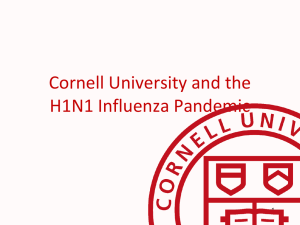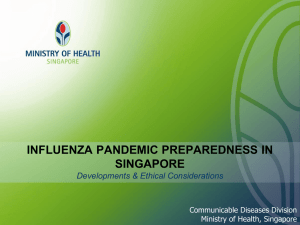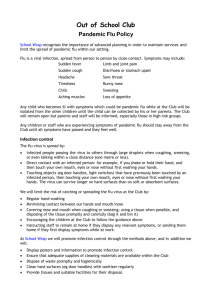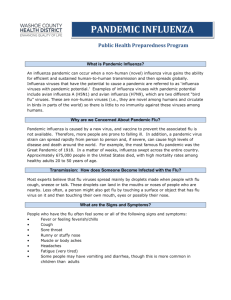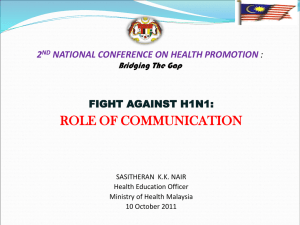AA-008-056 - Cal Poly Pomona
advertisement
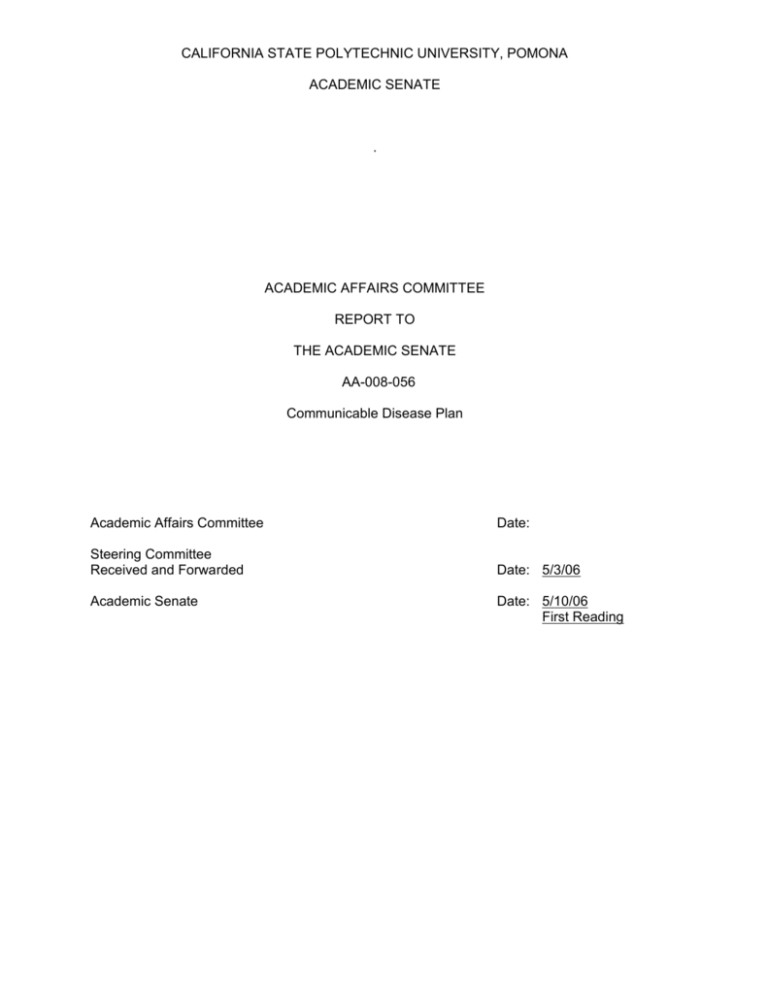
CALIFORNIA STATE POLYTECHNIC UNIVERSITY, POMONA ACADEMIC SENATE . ACADEMIC AFFAIRS COMMITTEE REPORT TO THE ACADEMIC SENATE AA-008-056 Communicable Disease Plan Academic Affairs Committee Date: Steering Committee Received and Forwarded Date: 5/3/06 Academic Senate Date: 5/10/06 First Reading AA-008-056, Communicable Disease Plan Background: This referral involves a plan for continuance and recovery of the university should there be a pandemic outbreak of an illness such as Avian flu. The University is creating a universitywide plan to protect students, faculty, and employee health and safety during such an epidemic. The Academic Senate has been asked to provide recommendations on ways in which the academic life of the university could continue operations during such a pandemic. In most large-scale crises (Hurricane Katrina, the tsunami), individuals volunteer to assist one another across organizational boundaries. Our plan assumes that members of the Cal Poly community will work together to ensure that the university survives as an institution of higher learning. General information about a possible avian flu pandemic A pandemic is a global epidemic that taxes all systems to the limit. Avian flu is moving with bird migration and is expected to come across the Arctic to Alaska and down the West Coast of the United States Avian flu spreads by droplets from a infected organism’s respiratory system, and is not airborne. Other avian flu strains have passed from birds to swine and swine to humans. There is no drug of choice against avian flu. Estimates are that an Avian flu pandemic could occur in 6-week waves, lasting from 6 months to 2 years in duration. The expected infection rate is 30% and the expected death rate is 1-2% of the population. However, in an age of readily available medical services, we can expect that many people would survive avian flu, and we have to plan for the survival of the university. There were 3 pandemics in the 20th century: the Spanish flu in 1918 (also an avian flu) which killed more people than World War I, the Hong Kong flu in 1957-58, and the Swine flu in 1968-69. According to the World Health Organization or WHO (http://www.who.int/csr/disease/avian_influenza/country/cases_table_2006_04_27/en/ index.html ), the confirmed number of avian flu A (H5N1) cases reported to WHO between 2003 and 2006 is 205. The total number of deaths is 113. This mortality rate appears very high especially since most of the afflicted were young and healthy, but there is speculation that only the most severe cases are diagnosed and reported. When would we know there is Avian flu pandemic? When avian flu is transferred easily from human to human. The LA County Department of Health would trigger the execution of the pandemic plan since they are responsible at the regional level. They maintain stockpiles of any available treatments. They would also determine who would get vaccines, when there is such a vaccine. The university working committee has prepared a Pandemic Planning Workbook which suggests issues the plan should address. The deadline for presenting the university plan to AA-008-056, Communicable Disease Plan the Chancellor’s Office is May 17, 2006. The authors of the plan can indicate that the academic segment is being prepared, if it has not completed its approval cycle by that time. The Academic Affairs Committee consulted a number of resources: Representatives of the University Administration. Janet Cain from Risk Management and Debbi McFall, the Emergency Services Coordinator of the University Police Department spoke to the Academic affairs Committee about the Pandemic Disease Plan for the University. Sharon Reiter, the Risk Management official responsible for developing this plan together with Debbi provided information over the telephone and sent a copy of the university workbook to the committee. David Levin and Debra Brum of I&IT Other CSU technology units, to investigate their course management infrastructure (e.g., Blackboard) Representatives of Academic Units Deans David Klock and Barbara Way Department Chairs. Faculty Sources of Information about the possible avian flu pandemic CDC checklist for Universities http://www.pandemicflu.gov/plan/collegeschecklist.html CDC Resources for Health Professionals http://www.cdc.gov/flu/avian/professional/ University of Albany School of Public Health has a 6-hour on-line course called Preparedness & Community Response to Pandemic: http://www.ualbanycphp.org/learning/registration/detail_Pandemics.cfm Discussion: The Pandemic Planning Workbook suggests the plan should cover 5 phases. A copy of this document is attached as an appendix. The Academic Affairs committee has collapsed some of these phases for the academic area of responsibility: The first two pre-pandemic phases are combined into a single planning and preparation phase The three pandemic phases are combined. The plan for this phase would apply in a scenario in which societal infrastructure (e.g., the telecommunications networks, electricity and water, health care, transportation systems, etc.) functioned so that levels of instruction could be maintained, at least to some degree. The final phase is post-pandemic recovery and could apply to two pandemic scenarios: o one in which instruction had been able to continue throughout the pandemic o another scenario in which the university was closed and needed to be restored to normal. AA-008-056, Communicable Disease Plan The department chairs, faculty, and deans we consulted all agree that academic units such as departments and colleges should each prepare their own detailed plans for continuing instruction during a possible pandemic, and for recovering after a possible pandemic. Academic programs and course delivery vary so much that a one-size-fits-all plan would not work. Recommendation: The Academic Affairs Committee recommends that Deans and Department chairs be responsible for creating the plan for each instructional unit, for maintaining information necessary to carry out the plan, and for acting as contact points during such a disruption as a pandemic might bring. Note: Some of the recommendations require approval by the CSU Chancellor’s Office and/or the State of California. The Committee understands that but includes them because they want to be sure that issues important to student and faculty welfare are not overlooked. The Academic Affairs Committee makes the following recommendations for each of the phases: A. Pre-pandemic phase prior to human-to-human contact Plan for continuing instruction during a Pandemic o Each instructional unit (college and department) should prepare a plan to continue instruction during a possible pandemic. Since instruction varies from college to college and department to department, colleges and departments should prepare a plan that suits their own circumstances. o This plan should make arrangements to maintain and continue instruction, if at all possible. Where possible, identify a backup set of instructors (at least 2) for each class. Anyone who is qualified to teach, including staff and administrators, can qualify as backup instructors. Prepare a database of contact information for each instructional unit that includes alternate phone numbers and other contact information. Ensure that this information is available during a crisis to those who need it. Establish alternative communication procedures: web sites, email, phone trees, fax, snail mail, in case some parts of the communication infrastructure become inoperable. Personnel Issues AA-008-056, Communicable Disease Plan o Personnel policies should be established prior to the pandemic, with procedures disseminated and processes established to deal with them: o Compensation during illness: o o ° Since a backup plan for instruction would mean that faculty would work extra to cover the courses of their colleagues when they are ill, and then might receive reciprocal help when they become ill, the rules about taking sick leave might need to be suspended or ignored. Newer faculty may not have adequate sick leave to cover the time of their illness. There should be allowances to assure they continue to be paid if they become ill and unable to teach for some period of time. For those who have extra sick leave to donate to others, there is a limit on the amount that can be donated to others. Sick leave donations do not appear to be an option, unless the rules are relaxed. However, individuals may also be reluctant to donate sick leave to others when they might need it themselves. Mechanisms for applying for absence should be established and a process for applying for them put into place. It should be possible to apply for absence on the Cal Poly Pomona website, as well as through the telephone or fax. Faculty and staff should not lose their jobs because they take a leave of any kind Possible Leave Options: Illness covered by sick leave Catastrophic leave of absence Leave of absence with pay, while classes are covered by colleagues (reciprocation expected) Leave of absence without pay, should the individual just not be able to participate in the instructional activity of the university. Probationary faculty with little accrued sick leave need special consideration. Plans for technological infrastructure and support to handle additional instructional traffic during a pandemic are essential. Strengthen the university telecommunications and server infrastructure to support increased on-line education, in courses for which that is possible. AA-008-056, Communicable Disease Plan Increase the human support for these systems so they will keep operating. Automatically prepare a Blackboard course management website for each section of each course. o While on-line instruction may not be possible for every course, Blackboard could be used as a communication tool, (discussion board, on-line chat, email) and as a place for students to submit assignments and receive grades and feedback from their teachers. Blackboard provides email lists and the ability to send email to those enrolled in a class. o Ensure that any backup faculty members are added to the Blackboard class list as teaching assistants. Should the instructor of record become ill or unavailable, a backup faculty member could step in to teach the class until the instructor of record recovers. o Provide Blackboard training for faculty during Fall Conference and at workshops during the summer and throughout the year? Blackboard is relatively simple to learn, and provides many tools. Consider podcasting for delivery of lectures. o Podcasting requires uploading recorded content to a server, and is a very simple technology to use. o Software and instruction in its use should be available to faculty. o A technical support person who could process recorded lectures, and make the podcasts available from the Cal Poly Intranet would reduce the faculty member’s need to understand the technology and would encourage its use. o Many students have the ability to receive podcasts on iPods and on their computers. B. Pandemic phase in which there is human-to-human transmission of the disease in Southern California Treatment of Students: o Students should be able to apply for a leave of absence while they are ill. Under normal circumstances, such a leave would require a physician's note, but since the availability of health care during a pandemic is uncertain and because students may stay home because they need to care for family members, their requests should be honored without backup documentation. AA-008-056, Communicable Disease Plan o Procedure needs to be set up so that students can request a leave of absence on-line or over the telephone when they become ill. This procedure should store the information in a database for later use, and automatically notify the instructors of the classes in which the students are enrolled. Students should be allowed to withdraw from classes or take incomplete grades Financial Aid o Students who receive financial aid should not lose it because they fail to complete the required number of units during a pandemic. Student athletes should be able to retain eligibility even though they are unable to complete the required units during a pandemic. Treatment of Faculty o We must recognize that a certain percentage of faculty, staff, and students may be ill at any given time, and that others may not be able to come to campus because they need to care for family members, or for other personal reasons. o In some cases instruction can be moved to other modalities such as the Blackboard course management system, podcasting of recorded lectures, email, etc. o Faculty should expect to take over for one another, but they may also expect to have someone help out should they become incapacitated or unable to teach. o Instruction should continue, using alternative modalities, or hygienic procedures (e.g., face masks, gloves) for classes that need to meet face-to-face. o Faculty who are on an RTP clock should have the clock stopped during the pandemic. Phase 3. Post-Pandemic recovery period Recovery should be incremental. Each unit should plan how they would recover as a unit. RTP process: o tenure-track and tenured faculty working on an RTP action or post-tenure review should have the clock stopped during the pandemic. Faculty who choose to opt out of duties during a pandemic should be able to return from a leave of absence and take up their jobs during the recovery period when the pandemic AA-008-056, Communicable Disease Plan subsides. This leave of absence should in no way be equivalent to giving up their positions. Entitlements of non-tenure track faculty need to be considered, according to their contractual requirements Students should be allowed to make up incompletes by repeating the parts of classes they have missed. o Students should receive priority registration in classes they had to drop because of illness or which they only partly finished. o Students who were unable to complete the separate co-requisite laboratory section of a class should be allowed to take it separately from the lecture section in which they must normally co-register. Such students should have priority in registering for the laboratory class so they can finish the course. o Students should be able to repeat classes without penalty. o Students should be guaranteed incompletes when they become ill, even if they are unable to notify the university immediately.
